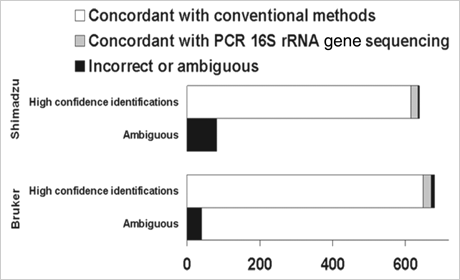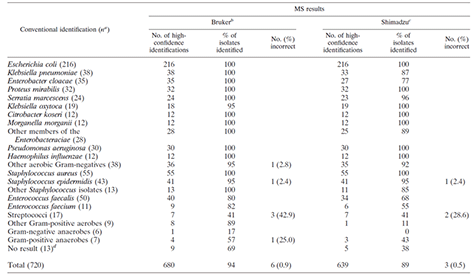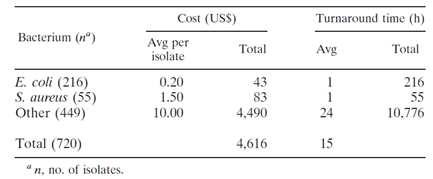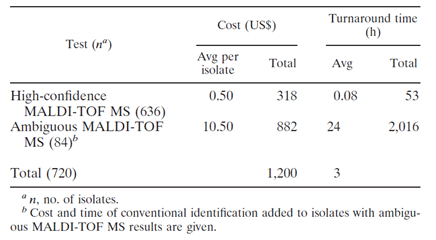|

Urine, stools, respiratory tract 등 human infection에 관한 미생물 720개의 isolates를 이용하여 미생물 동정 실험을 진행하였다. Figure 2에서 Bruker사의 MS system과 Shimadzu사의 MS system 모두에서 대부분의 미생물들이 정확히 동정이 되는 것을 확인 할 수 있다. 정확하게 살펴 보면 Bruker사의 MALDI Biotyper의 경우 720 isolates 중에서 680개인 94.4%가 high confidence level로 동정 되었으며 Shimadzu사의 MS system의 경우에는 639개인 88.8%가 high confidence level로 동정이 되었다. (Table 1.)

FIG. 2. Accuracy of MALDI-TOF MS identifications
of 720 clinical isolates.
Bruker사와 Shimadzu사의 MS system에서 high confidence level로 각각 일치한 균종 680개, 639개 중에서 첫 번째 분석에서는 동정이 되지 않았으나 재분석에서 high confidence level로 동정된결과는 각각 39/680(Bruker사), 54/639(Shimadzu사)로 확인 되었다. 즉, 최초 실험에서 high confidence level로 동정된 결과는 720개의 isolates중에서 Bruke사는 641개, Shimadzu사는 585개이다.
TABLE 1. High-confidence identifications
by MALDI-TOF system and taxonomy

a n, no. of isolates.
b The six incorrect Bruker results were as follows: one isolate identified as Achromobacter xylosoxidans by 16S analysis, not identified by biochemical methods, and identified as Achromobacter denitrificans by MS; one isolate not identified by 16S analysis, identified as Staphylococcus epidermidis by biochemical methods, and identified as Staphylococcus capitis by MS; one isolate identified to the genus level only by 16S analysis, identified as Streptococcus mitis by biochemical methods, and identified as Streptococcus pneumoniae by MS; two isolates identified to the genus level only by 16S analysis, identified as Streptococcus bovis by biochemical methods, and identified as Streptococcus lutiensis by MS; and one isolate identified as Clostridium boltei by 16S analysis, not identified by biochemical methods, and identified as Clostridium casei by MS.
c The three incorrect Shimadzu results were as follows: one isolate identified to the genus level only by 16S, identified as Staphylococcus epidermidis by biochemical methods, and identified ambiguously as Staphylococcus capitis or Staphylococcus caprae by MS; two isolates identified to the genus level only by 16S analysis, as Streptococcus mitis by biochemical methods, and as Streptococcus oralis and Streptococcus pneumoniae by MS.
d See footnote b of Table 3.
Table 2는 phenotypic method에서 미생물을 동정하는데 사용되는 비용 및 시간을 계산한 결과이며 Table 3에서는 Bruker사의 MALDI-TOF MS system을 이용한 미생물 동정에서 사용되는 비용 및 시간을 나타내었다. 결과적으로 MALDI-TOF MS system을 이용한 미생물 동정이 기존의 방법에 비해서 비용 및 시간이 매우 절약되는 것을 알 수 있다.
TABLE 2. Cost and timeliness estimates of conventional identification

TABLE 3. Cost and timeliness estimates of MALDI-TOF MS (Bruker) followed by conventional identificationy

 |
|
 |
본 연구는 Bruker사와 Shimadzu사의 MALDI-TOF MS를 이용하여 미생물 동정을 실시하고 비교 분석하였으며 MALDI-TOF와 기존 phenotypic method와의 동정 비용 및 시간을 비교하였다. |
|
 |
Bruker사의 MALDI-TOF MS 시스템에서는 720개의 isolates중에서 680개(95%)가 high confidence로 동정이 되었고 Shimadzu사의 MALDI-TOF MS 시스템에서는 720개중 639개(89%)가 high confidence level로 동정이 되었다. |
|
 |
결론적으로 Phenotypic method와 PCR방법 대비 MALDI-TOF MS system을 이용한 미생물 동정법은 비용 및 시간 절약 측면에서 매우 효율적인 장비이다. |
|